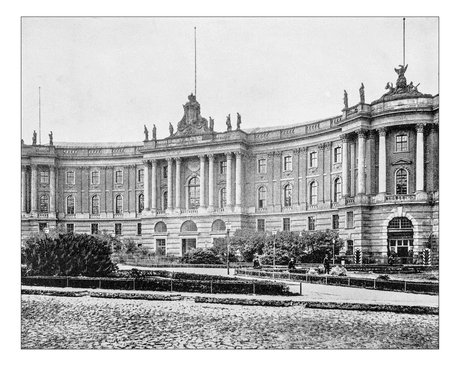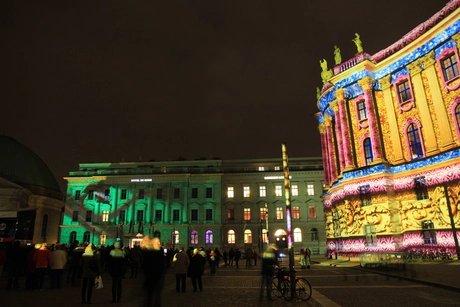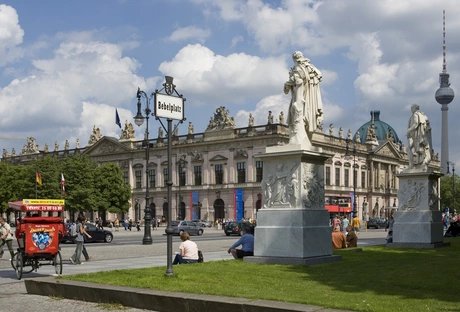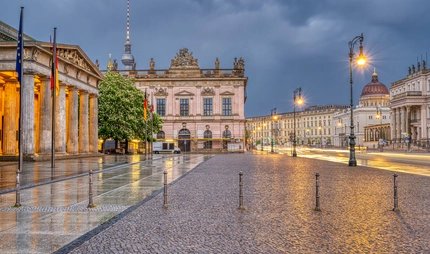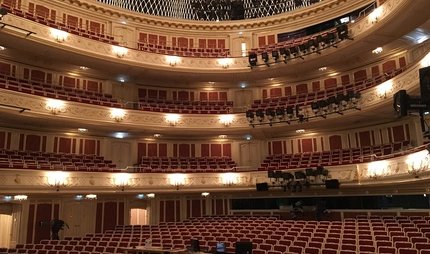
Bebelplatz
From the bright dawn of the Enlightenment to the dark days of dictatorship
With its magnificent buildings, Bebelplatz is one of Berlin’s most attractive public squares – and it has also been the scene of some of the city’s chequered history.
Bebelplatz in the centre of Berlin has seen a lot: from the bright light of the Enlightenment to the dark hours of National Socialism. Even today, it tells you about its eventful history.
Located directly on the grand boulevard Unter den Linden , you can reach Bebelplatz quickly. It is one of the most striking and historically important squares in Berlin. Bebelplatz is home to buildings worth seeing such as the Staatsoper Unter den Linden, St Hedwig's Cathedral, the Hotel de Rome, the Alte Bibliothek, the Alte Palais and the Prinzessinnenpalais.
The square was originally called Platz am Opernhaus, later Kaiser-Franz-Joseph-Platz.
In 1947, the authorities named it after the SPD politician August Bebel.
The Forum Fridericianum
The rectangular, fully paved square was created in 1740 after the old Berlin city fortifications were demolished. At the request of Frederick II, the architect von Knobelsdorff planned a new complex in the centre of Berlin, the Forum Fridericianum. The new square is to become the centre of the Forum Fridericianum with the opera house, academy building and royal city palace. However, von Knobelsdorff was unable to complete the original plans. Initially, only the opera building was built, whereupon the site was given the name Opernplatz. The Catholic St Hedwig's Cathedral has stood behind the State Opera since the late 18th century, while the Royal Library and the Old Palace are built on the west side.
Building on Bebelplatz
- Staatsoper Unter den Linden
The Staatsoper is the first free-standing opera house in Germany. Numerous important artists have worked on performances at the opera house. - Prinzessinnenpalais: Today's PalaisPopulaire
At one time, members of the Hohenzollern family lived in the palace, Today, art exhibitions are shown there. The palace originally consisted of two buildings, which were joined together and later given a prestigious extension. Karl Friedrich Schinkel erected a floor construction that connects the building with the neighbouring Kronprinzenpalais. Today, exhibitions from the Deutsche Bank Collection and presentations of the "Artist of the Year" programme from international cooperation partners or private collections are shown here. - Sankt Hedwigs-Kathedrale
Friedrich II. donated St Hedwig's Cathedral to the Catholic community as a sign of religious tolerance. Today, the church with its striking dome is the episcopal church of Berlin and therefore the most important Catholic religious building in the city. After many years of renovation, St Hedwig's Cathedral will be ceremoniously reopened on 24 November 2024 at Christmas time. In the heart of Berlin, it fascinates with its striking dome and the modern, simple interior, which has been extensively renovated. - Old Palace
The Old Palace was once the capital residence of the Prussian King and German Emperor Wilhelm I. He liked to show himself at the window for the changing of the guard. This event attracted onlookers and was even featured in Berlin travel guides of the time. Today, the building belongs to the Humboldt University of Berlin as part of the Faculty of Law. - Hotel de Rome
The former business headquarters of Dresdner Bank from the late 19th century in the style of the Italian Renaissance. - The old library
Built in the 18th century, the library is nicknamed the 'chest of drawers' because of its curved baroque forms. With the library, Frederick II wanted to make academic knowledge accessible to the bourgeoisie. The library's shelves held important works of the Enlightenment, including books by Diderot, Rousseau, Voltaire, Kant and Leibniz: the largest library in the German-speaking world. When the building could no longer hold the books, the Staatsbibliothek Unter den Linden.
Dramatic moments: the book burning
On 10 May 1933, Opernplatz went down in history in an inglorious way. Members of the National Socialist German Student Union throw important works of world literature into the fire during a major book burning. Works by authors such as Heinrich and Thomas Mann, Erich Kästner, Stefan Zweig, Heinrich Heine, Karl Marx and Kurt Tucholsky are burnt. Many of the writers who were reviled as decadent and un-German had already left Germany by this time and gone into exile.
Did you know that Erich Kästner watched unrecognised in the crowd as his books were burned?
Our App ABOUT BERLIN presents the story behind the book burning and many other exciting stories about Berlin's history.
The memorial to the burning of books
The book burning has been commemorated since 1995 by Micha Ullmann. The underground Memorial to the Memory of the Book Burning shows a library with empty shelves set into the ground, which can be viewed through a plastic pane in the centre of Bebelplatz.
The inscription quotes Heinrich Heine: "That was just a prelude, where you burn books, you end up burning people too."
.

